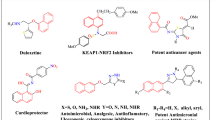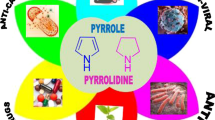Abstract
Ruthenium(II) arene anticancer complexes [(η 6-arene)Ru(en)Cl]PF6 (arene is hexamethylbenzene, p-cymene, indan; en is ethylenediamine) can catalyse regioselective reduction of NAD+ by formate in water to form 1,4-NADH, at pD 7.2, 37 °C, and in the presence of air. The catalytic activity is markedly dependent on the arene, with the hexamethylbenzene (hmb) complex showing the highest activity. For [(η 6-hmb)Ru(en)Cl]PF6, the rate of reaction is independent of NAD+ concentration and shows saturation kinetics with respect to formate concentration. A K m value of 58 mM and a turnover frequency at saturation of 1.46 h−1 were observed. Removal of chloride and performing the reaction under argon led to higher reaction rates. Lung cancer cells (A549) were found to be remarkably tolerant to formate even at millimolar concentrations. The possibility of using ruthenium arene complexes coadministered with formate as catalytic drugs is discussed.







Similar content being viewed by others
References
Westerhausen D, Herrmann S, Hummel W, Steckhan E (1992) Angew Chem Int Ed Engl 31:1529–1531
Wong C, Drueckhammer DG, Sweers HM (1985) J Am Chem Soc 107:4028–4031
Kragl U, Vasic-Racki D, Wandrey C (1996) Bioprocess Eng 14:291–297
Wagenknecht PS, Sambriski EJ (2003) Recent Res Dev Inorg Chem 3:35–50
Lo HC, Buriez O, Kerr JB, Fish RH (1999) Angew Chem Int Ed Engl 38:1429–1432
Ogo S, Abura T, Watanabe Y (2002) Organometallics 21:2964–2969
Steckhan E, Herrmann S, Ruppert R, Dietz E, Frede M, Spika E (1991) Organometallics 10:1568–1577
Lo HC, Leiva C, Buriez O, Kerr JB, Olmstead MM, Fish RH (2001) Inorg Chem 40:6705–6716
Yan YK, Melchart M, Habtemariam A, Sadler PJ (2005) Chem Commun 38:4764–4776
Melchart M, Sadler PJ (2006) In: Jaouen G (ed) Bioorganometallics: biomolecules, labeling, medicine. Wiley-VCH, Weinheim, Chap 2
Morris RE, Aird RE, Murdoch PdS, Chen H, Cummings J, Hughes ND, Parsons S, Parkin A, Boyd G, Jodrell DI, Sadler PJ (2001) J Med Chem 44:3616–3621
Fernandez R, Melchart M, Habtemariam A, Parsons S, Sadler PJ (2004) Chem Eur J 10:5173–5179
Wang F, Habtemariam A, van der Geer EPL, Fernandez R, Melchart M, Deeth RJ, Aird R, Guichard S, Fabbiani FPA, Lozano-Casal P, Oswald IDH, Jodrell DI, Parsons S, Sadler PJ (2005) Proc Natl Acad Sci USA 102:18269–18274
Gottlieb HE, Kotlyar V, Nudelman A (1997) J Org Chem 62:7512–7515
Glasoe PK, Long FA (1960) J Phys Chem 64:188–190
Skehan P, Storeng R, Scudiero D, Monks A, McMahon J, Vistica D, Warren JT, Bokesch H, Kenney S, Boyd MR (1990) J Natl Cancer Inst 82:1107–1112
Ruppert R, Herrmann S, Steckhan E (1988) J Chem Soc Chem Commun 1150–1151
Chen H, Parkinson JA, Morris RE, Sadler PJ (2003) J Am Chem Soc 125:173–186
Acknowledgments
We thank the Edinburgh Technology Fund, EC, Wellcome Trust, EPSRC (Studentship for A.F.A.P.) and Oncosense Ltd for support. Y.-K.Y. is grateful to the Nanyang Technological University, Singapore, for granting him leave and financial support for his visit to the University of Edinburgh. We thank Rhona Aird and Duncan Jodrell for advice and assistance with cell culture.
Author information
Authors and Affiliations
Corresponding author
Electronic supplementary material
Rights and permissions
About this article
Cite this article
Yan, Y.K., Melchart, M., Habtemariam, A. et al. Catalysis of regioselective reduction of NAD+ by ruthenium(II) arene complexes under biologically relevant conditions. J Biol Inorg Chem 11, 483–488 (2006). https://doi.org/10.1007/s00775-006-0098-5
Received:
Accepted:
Published:
Issue Date:
DOI: https://doi.org/10.1007/s00775-006-0098-5




